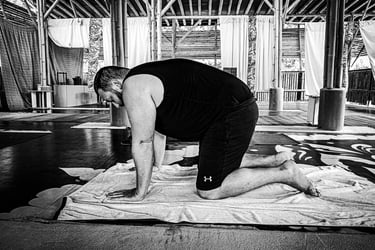Spinal Decompression : Table Top
Many may recognise how babies adopt a posture similar to the Table Top - rocking back and forth - between 6-9 months age. This movement helps to strengthen the core, arms, and legs as they prepare to crawl and stand.
For adults, Table Top engages the deep abdominal muscles, shoulders, and hip flexors, helping to stabilise the spine. It is often used as a transitional pose to improve mobility and core strength.
This makes the Table Top a key foundation pose in our spinal strength classes and back pain management workshops.


The Table Top Pose, though often overlooked, can offer significant benefits to the spine, especially when well-aligned and combined with conscious lengthening. Compared to Downward Dog, which also helps with spinal decompression, Table Top may be less intense but more accessible, allowing for a gentler and more focused engagement of spinal muscles.
Incorporating side bends into Table Top adds the benefit of stretching and strengthening the muscles along either side of the abdomen, improving lateral flexibility and promoting better spinal alignment.
This makes Table Top a valuable pose, particularly for those who may find the muscle work required in Downward Dog challenging, offering a more controlled approach to spinal decompression and overall spinal health.
Further Reading: Babies : Intuitive Beginners
More Insights
